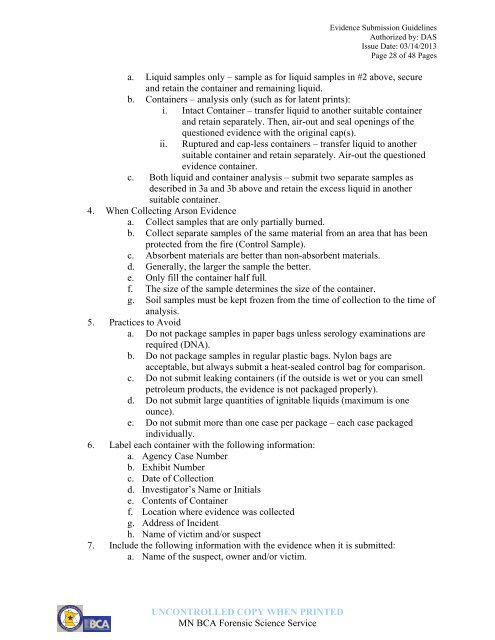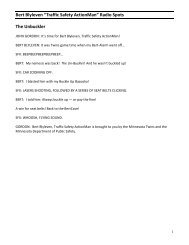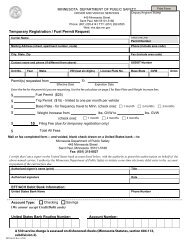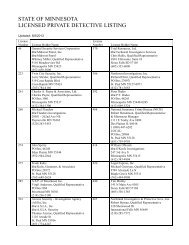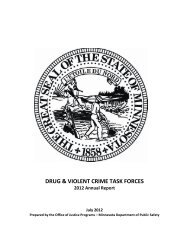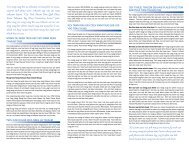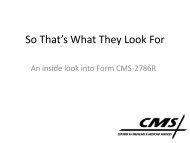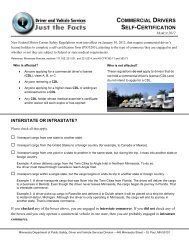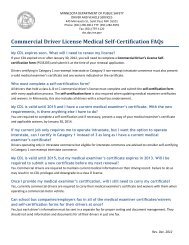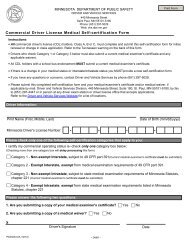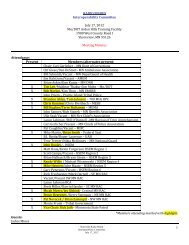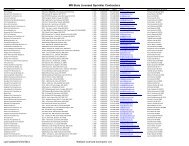Evidence Submission Guidelines - Minnesota Department of Public ...
Evidence Submission Guidelines - Minnesota Department of Public ...
Evidence Submission Guidelines - Minnesota Department of Public ...
Create successful ePaper yourself
Turn your PDF publications into a flip-book with our unique Google optimized e-Paper software.
UNCONTROLLED COPY WHEN PRINTED<br />
MN BCA Forensic Science Service<br />
<strong>Evidence</strong> <strong>Submission</strong> <strong>Guidelines</strong><br />
Authorized by: DAS<br />
Issue Date: 03/14/2013<br />
Page 28 <strong>of</strong> 48 Pages<br />
a. Liquid samples only – sample as for liquid samples in #2 above, secure<br />
and retain the container and remaining liquid.<br />
b. Containers – analysis only (such as for latent prints):<br />
i. Intact Container – transfer liquid to another suitable container<br />
and retain separately. Then, air-out and seal openings <strong>of</strong> the<br />
questioned evidence with the original cap(s).<br />
ii. Ruptured and cap-less containers – transfer liquid to another<br />
suitable container and retain separately. Air-out the questioned<br />
evidence container.<br />
c. Both liquid and container analysis – submit two separate samples as<br />
described in 3a and 3b above and retain the excess liquid in another<br />
suitable container.<br />
4. When Collecting Arson <strong>Evidence</strong><br />
a. Collect samples that are only partially burned.<br />
b. Collect separate samples <strong>of</strong> the same material from an area that has been<br />
protected from the fire (Control Sample).<br />
c. Absorbent materials are better than non-absorbent materials.<br />
d. Generally, the larger the sample the better.<br />
e. Only fill the container half full.<br />
f. The size <strong>of</strong> the sample determines the size <strong>of</strong> the container.<br />
g. Soil samples must be kept frozen from the time <strong>of</strong> collection to the time <strong>of</strong><br />
analysis.<br />
5. Practices to Avoid<br />
a. Do not package samples in paper bags unless serology examinations are<br />
required (DNA).<br />
b. Do not package samples in regular plastic bags. Nylon bags are<br />
acceptable, but always submit a heat-sealed control bag for comparison.<br />
c. Do not submit leaking containers (if the outside is wet or you can smell<br />
petroleum products, the evidence is not packaged properly).<br />
d. Do not submit large quantities <strong>of</strong> ignitable liquids (maximum is one<br />
ounce).<br />
e. Do not submit more than one case per package – each case packaged<br />
individually.<br />
6. Label each container with the following information:<br />
a. Agency Case Number<br />
b. Exhibit Number<br />
c. Date <strong>of</strong> Collection<br />
d. Investigator’s Name or Initials<br />
e. Contents <strong>of</strong> Container<br />
f. Location where evidence was collected<br />
g. Address <strong>of</strong> Incident<br />
h. Name <strong>of</strong> victim and/or suspect<br />
7. Include the following information with the evidence when it is submitted:<br />
a. Name <strong>of</strong> the suspect, owner and/or victim.


